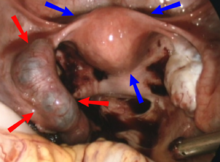Hematosalpinx
| Classification according to ICD-10 | |
|---|---|
| N83.6 | Hematosalpinx |
| ICD-10 online (WHO version 2019) | |
The hematosalpinx (from ancient Greek αἷμα haima , German ' blood ' and ancient Greek σαλπίγξ salpinx , German ' fallopian tube ' ) is an accumulation of blood in one or both fallopian tubes ( Latin tuba uterina ).

Laparoscopy from above into the small pelvis. Uterus ( blue arrows ). On the left, the uterine tuba with ectopic pregnancy and hematosalpinx ( red arrows ). The opposite side is normal.
root cause
Possible causes are:
- Ectopic pregnancy
- Endometriosis , the two most common causes
- Salpingitis and other inflammation in the pelvis
- Tube torsion (twisting of the fallopian tube around its own longitudinal axis)
- Tube carcinoma
- trauma
- as a complication of a hematocolpos
Clinical manifestations
The clinical criteria depend on the cause, see there in each case.
diagnosis
The first and groundbreaking diagnostic step after the clinical examination is sonography . Laparoscopy will often be necessary.
literature
- M. Nacharaju, VS Vellanki, SB Gillellamudi, VK Kotha, A. Alluri: A rare case of chronic ectopic pregnancy presenting as large hematosalpinx. In: Clinical medicine insights. Reproductive health. Vol. 8, 2014, pp. 1-4, doi: 10.4137 / CMRH.S13110 , PMID 24812530 , PMC 4007565 (free full text).
- CL Diehl, LP Gavrilova-Jordan, CC Coddington: Acute abdominal pain as a result of a ruptured hematosalpinx: a rare complication of an unusual müllerian anomaly. In: Journal of pediatric and adolescent gynecology. Vol. 22, No. 3, June 2009, pp. E9–11, doi: 10.1016 / j.jpag.2008.02.005 , PMID 19539197 .
- T. Römer, B. Bojahr, G. Schwesinger: Treatment of a torqued hematosalpinx in the thirteenth week of pregnancy using gasless laparoscopy. In: The Journal of the American Association of Gynecologic Laparoscopists. Vol. 9, No. 1, February 2002, pp. 89-92, PMID 11821614 .
Individual evidence
- ^ Willibald Pschyrembel : Clinical Dictionary , 266th, updated edition, de Gruyter, Berlin 2014, ISBN 978-3-11-033997-0
- ↑ Radiopaedia